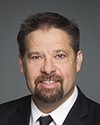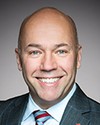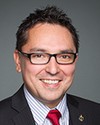To get started today, we're going to be talking to you about our upstream suicide prevention program called Cuystwi. As we know, indigenous suicide isn't a new issue in Canada. It was established as a priority action area in the “Transformative Change Accord: First Nations Health Plan” back in 2005. To ground the rest of our talk, I want to give some background on the values and the philosophy that we use in our programming.
One of the main points is that colonization and racism are determinants of health for indigenous people. I think that's something that really needs to be kept at the forefront when we're looking at prevention efforts. Secondly, we use evidence from the literature that states that identity, culture, and connections to land are really important when we're talking about indigenous youth suicide prevention.
That brings us to Cuystwi and how we got started with our program. We were doing some work with first nations communities in northern B.C., and they had expressed desire for an upstream suicide prevention programming for their youth. They really wanted a program that would teach youth our history from the indigenous perspective. They requested that it should be culturally relevant and would promote wellness, and that it would be culturally safe and decolonizing in nature.
With that feedback, we hosted four World Café-style focus groups in the north where we brought youth together to flesh out what that meant to them and what they wanted to see. When we got some positive feedback from those youth, we moved on to a think tank in Vancouver in 2012, where we brought youth and youth workers from 20 different nations together to really flesh out what that would look like to them. On the slides, you can see one of the drawings representing what the youth wanted to see.
With that positive feedback and the direction from the youth, we embarked on the creation of an online quest called Cuystwi. It's meant for youth aged 10 to 12 and it's designed so they go through a journey with many different activities, videos, and audio. That was one of the things that they expressed; they wanted it to be interactive and they wanted to use media tools. The online quest can be explored either as an individual or as a group. It's meant to be facilitated in community, by community members, and to complement other existing youth programs.
The quests were really meant to be a conversation starter and not meant to be the be-all and end-all of information. We really wanted to provide a platform that communities could use to make it their own; to have their own teachings and their own values that they could bring to the table.
That being said, the five main themes that the quest goes through are strengthening identity, understanding the importance of culture and wellness, understanding colonization and how it affects us, our families, and our communities. It gives them some tools to deal with racism and it ends with an invitation to become a young warrior.
From there, we moved on to the development of phase 2 Cuystwi. There was a desire expressed that we wanted to address some of the older age groups, so this one was for 13- to 15-year olds. It has a very similar style with an online quest that youth can go through again, either by themselves or in a group. We built on the five main themes from phase 1, but we also added on topics like healthy relationships, and that can be with the land, our friends, our families, and significant others. We talk about sexuality, self-regulation and emotions, and we really go into more depth around the Indian Act and residential schools, again, teaching our history from our perspective. Both programs are free to use. You send us an email and we'll send you a link.
We also provide facilitator manuals, so that communities have a resource, in addition to accessibility to needed support. Again, we really want to emphasize that it's something that communities can take and use in the way they see fit. They don't need to use it exactly the way the quest is laid out. It's meant so the youth can take what they want to learn and supplement it into their other programming.
As best practice, we really believe in having youth-driven programming, with the understanding that youth know what they need. Many health promotion programs have been implemented without an indigenous world view or real and meaningful engagement or collaboration with the people who actually would be using the services they're developing. We believe that youth need to be recognized as experts in determining what they need to stay well and we really need to fully support and engage youth, so they are part of the development from the very beginning when we're moving forward with programming. This really helps to ensure that there are high rates of participation, that people feel like they have a sense of ownership over the content, and take pride in their communities.
With that being said, we also want to recognize that indigenous youth aren't one specific group. When we're talking about programming, we really need to be understanding that there's youth on-reserve, in foster care, and in urban settings, so we really need to address all of those.
One of the ways that we've been ensuring that we have youth involvement in our development of our programming is that we had 12 pilot communities from around B.C. We asked those communities to send us youth representatives who were interested in sitting on an advisory panel. It was an advisory panel where they could provide direct feedback and help develop content with us, but it was also an opportunity for youth to get some training. We used telehealth equipment, so that we could bring in people to provide training around research, facilitation, skills, and leadership, etc., so that they could go back into their communities to solicit more feedback from youth in their communities, and it had a ripple effect outwards.
We always make sure we pay our youth to give us their time, and we honour them for their contributions. I think that's really important.
We have facilitator gatherings so that community members can send representatives and young people down to learn about how they can use Cuystwi in their communities, as well as gain skills around facilitation.
We have a youthful team. We try to keep our team with youth under 25, which I think is really important, so that youth are at the table not only when we're in the workplace, but also when we're in a community.
One of the main ways right now that we ensure that we have youth involvement is to do a lot of video workshops around the province. It's not only a way to help youth gain skills to tell their stories through media, but it's a way that we can work with them to create content that's relevant and meaningful to them.
One of the benefits that we've seen from doing our work this way is that it's decolonizing in nature. It gives us an opportunity again to learn our history from our perspectives. We have youth at the table developing the content and making sure it's relevant, and they're going to be interested in what you're creating.
It's skills building, and it's not only for our staff. We believe in mentoring, so we do hire young people and help them figure out what their passion is, but also with the communities we work with, their youth are gaining skills as well. It's a lot of fun being able to work with youth, and most importantly, we believe that it's important that youth are able to see themselves in the content and that it's not just a resource. They can connect with it.
Now I'm going to turn it over to Cassandra, who is going to share a bit of her story.





